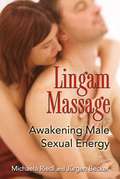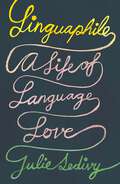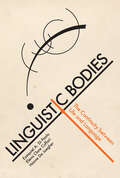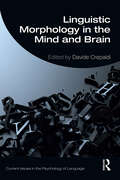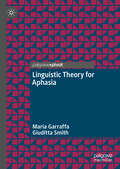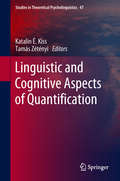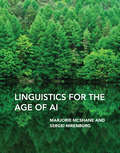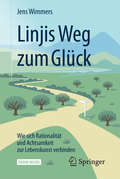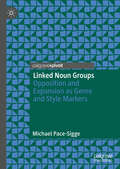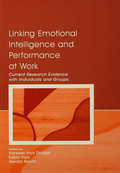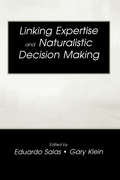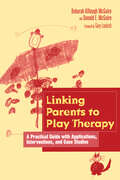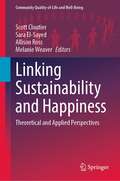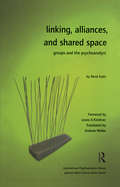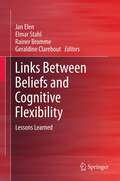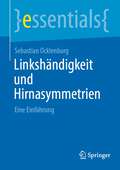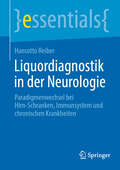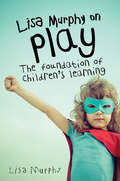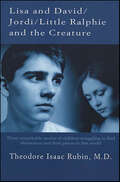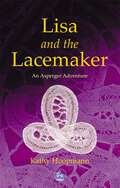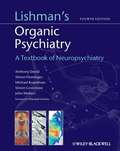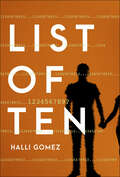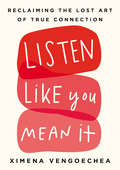- Table View
- List View
Lingam Massage: Awakening Male Sexual Energy
by Jürgen Becker Michaela RiedlA tantric massage practice for awakening and honoring male creative energy and allowing a man conscious, loving contact with his own masculinity • Empowers men to expand and deepen their experience of arousal and sensuality • Demonstrates how deep relaxation is important to a strong and lasting erection • Shows how the lingam connects a man to his dynamic strength while the prostate is linked to his more receptive side Lingam is the Sanskrit word for the male generative organ, the penis. In India, the lingam is revered as an expression of Shiva’s clarity, symbolizing the fine sword that differentiates between truth and falsehood. The goal of a lingam massage is to provide a man conscious, loving contact with his own masculinity. Western cultural expectations around sexual “performance” have created sexual difficulties for many men, including erectile dysfunction and premature ejaculation. Through loving touch, lingam massage provides the deep relaxation that supports sustained erection, putting a man in touch with less familiar aspects of his sexuality, including the energetic responses of his perineum, prostate gland, and anus. Lingam massage is not simply a hands-on technique but involves the conscious direction of energy throughout the body. It allows men to savor longer, deeper orgasms and teaches taoist and tantric practices for conserving sexual energy. Over time, as his consciousness deepens, these practices give a man complete control over his ejaculation.
Linguaphile: A Life of Language Love
by Julie SedivyA celebration of the beauty and mystery of language and how it shapes our lives, our loves, and our world.If there is one feature that defines the human condition, it is language: written, spoken, signed, understood, and misunderstood, in all its infinite glory. In this ingenious, lyrical exploration, Julie Sedivy draws on years of experience in the lab and a lifetime of linguistic love to bring the discoveries of linguistics home, to the place language itself lives: within the yearnings of the human heart and amid the complex social bonds that it makes possible.Linguaphile: A Life of Language Love follows the path that language takes through a human life—from an infant’s first attempts at sense-making to the vulnerabilities and losses that accompany aging. As Sedivy shows, however, language and life are inextricable, and here she offers them together: a childish misunderstanding of her mother’s meaning reveals the difficulty of relating to other minds; frustration with “professional” communication styles exposes the labyrinth of standards that define success; the first signs of hearing loss lead to a meditation on society’s discomfort with physical and mental limitations.Part memoir, part scientific exploration, and part cultural commentary, this book epitomizes the thrills of a life steeped in the aesthetic delights of language and the joys of its scientific scrutiny.
Linguistic Bodies: The Continuity between Life and Language
by Elena Clare Cuffari Ezequiel A. Di Paolo Hanne De JaegherA novel theoretical framework for an embodied, non-representational approach to language that extends and deepens enactive theory, bridging the gap between sensorimotor skills and language. Linguistic Bodies offers a fully embodied and fully social treatment of human language without positing mental representations. The authors present the first coherent, overarching theory that connects dynamical explanations of action and perception with language. Arguing from the assumption of a deep continuity between life and mind, they show that this continuity extends to language. Expanding and deepening enactive theory, they offer a constitutive account of language and the co-emergent phenomena of personhood, reflexivity, social normativity, and ideality. Language, they argue, is not something we add to a range of existing cognitive capacities but a new way of being embodied. Each of us is a linguistic body in a community of other linguistic bodies. The book describes three distinct yet entangled kinds of human embodiment, organic, sensorimotor, and intersubjective; it traces the emergence of linguistic sensitivities and introduces the novel concept of linguistic bodies; and it explores the implications of living as linguistic bodies in perpetual becoming, applying the concept of linguistic bodies to questions of language acquisition, parenting, autism, grammar, symbol, narrative, and gesture, and to such ethical concerns as microaggression, institutional speech, and pedagogy.
Linguistic Morphology in the Mind and Brain (Current Issues in the Psychology of Language)
by Davide CrepaldiLinguistic Morphology is a unique collection of cutting-edge research in the psycholinguistics of morphology, offering a comprehensive overview of this interdisciplinary field. This book brings together world-leading experts from linguisics, experimental psychology and cognitive neuroscience to examine morphology research from different disciplines. It provides an overview of how the brain deals with complex words; examining how they are easier to read, how they affect our brain dynamics and eye movements, how they mould the acquisition of language and literacy, and how they inform computational models of the linguistic brain. Chapters discuss topics ranging from subconscious visual identification to the high-level processing of sentences, how children make their first steps with complex words through to how proficient adults make lexical identification in less than 40 milliseconds. As a state-of-the-art resource in morphology research, this book will be highly relevant reading for students and researchers of linguistics, psychology and cognitive neuroscience. It will also act as a one-stop shop for experts in the field.
Linguistic Theory for Aphasia
by Maria Garraffa Giuditta SmithThis book presents a cutting-edge overview of the language models of in phonology, morphology, syntax, and pragmatics, proposed to underlie language phenotypes across aphasic syndromes, as well as the potential applications of linguistic theory to advance therapeutic treatment -and research- in aphasiology. It draws together examples from a range of aphasic syndromes, providing valuable insights into the way language-specific properties may affect the manifestation of language deficits across aphasia. The authors discuss experimental evidence of deficits across language domains, which is crucial to those who study language abilities in aphasia. It concludes by examining how linguistic theory might contribute to patient classification in aphasia and to future directions for research in experimental linguistics and aphasiology. This book will appeal to students and scholars of neuropsychology, psycholinguistics, linguistics, and speech and language therapy.
Linguistic and Cognitive Aspects of Quantification (Studies in Theoretical Psycholinguistics #47)
by Katalin É. Kiss Tamás ZétényiThis volume presents the results of psycholinguistic research into various aspects of the grammar of quantification. The investigations involve children and adults, speakers of different languages, using a variety of experimental paradigms. A shared aspect of the studies is that they present their experimental results as evidence evaluating linguistic theories of quantification. Topics discussed include the interpretation of universal, comparative, and superlative quantifiers, quantifier spreading, scope interaction between pairs of quantifiers and between quantifiers and wh-phrases, distributivity and cumulativity, the interaction of quantifier interpretation with information structure, the disambiguating role of prosody, the functional overlap between universal quantification and perfectivity, and much more. The focus on experimental evidence makes this book essential reading for linguists (syntacticians, semanticists and pragmatists), psycholinguists and psychologists interested in quantification.
Linguistics for the Age of AI
by Sergei Nirenburg Marjorie McshaneA human-inspired, linguistically sophisticated model of language understanding for intelligent agent systems.One of the original goals of artificial intelligence research was to endow intelligent agents with human-level natural language capabilities. Recent AI research, however, has focused on applying statistical and machine learning approaches to big data rather than attempting to model what people do and how they do it. In this book, Marjorie McShane and Sergei Nirenburg return to the original goal of recreating human-level intelligence in a machine. They present a human-inspired, linguistically sophisticated model of language understanding for intelligent agent systems that emphasizes meaning--the deep, context-sensitive meaning that a person derives from spoken or written language.
Linjis Weg zum Glück: Wie sich Rationalität und Achtsamkeit zur Lebenskunst verbinden
by Jens WimmersWie kommen Glück und Sinn zusammen? Dieses Buch ist ein Wegweiser zu einer neuen Form der Lebenskunst. Wir gehen davon aus, dass der Schlüssel zum Glück in der Veränderung des eigenen Bewusstseins liegt. Die Art und Weise, wie wir uns selbst und unsere Umwelt wahrnehmen, entscheidet maßgeblich darüber, ob wir glücklich werden. Aber als moderne, selbstbestimmte Menschen folgen wir noch einem weiteren Ziel: Wir wollen unser Leben sinnvoll gestalten. Sinn und Glück sind die zentralen Herausforderungen für eine gelingende Lebensführung. Doch zwischen dem intuitiven Glücksempfinden und unserem rationalen Denken wird häufig ein einander ausschließender Widerspruch ausgemacht. Demnach könne nur glücklich werden, wer sich von den Zwängen der Rationalität befreit. Das Buch zeigt, dass ein solches Verständnis die tiefere Dimension von Glück und Sinn noch nicht erfasst. Denn zum Glück im Ganzen gehört auch das Verstehen der Sinnzusammenhänge. Und wer in schwierigen Entscheidungssituationen intuitives Glücksempfinden berücksichtigt, handelt klug, weil er damit die Möglichkeiten der Rationalität voll ausschöpft.Jens Wimmers zeigt anhand der philosophischen Interpretation der Achtsamkeitslehre des Abts Linji, wie „Herz“ und „Kopf “ miteinander verbunden sind. Dies führt zu einem tieferen Verständnis für das, was ein gelingendes Leben ausmacht: die Einheit von glücklichem Empfinden und sinnvollem Entscheiden. Die hier an praktischen Beispielen vorgestellte Lebenskunst ist die bewusste Erweiterung von Achtsamkeit und Rationalität. Sie ermöglicht uns, das Leben so zu gestalten, dass das eigene Glück sinnvoll wird und der erkannte Sinn glücklich macht.
Linked Noun Groups: Opposition and Expansion as Genre and Style Markers
by Michael Pace-SiggeThis book provides a corpus-led analysis of multi-word units (MWUs) in English, specifically fixed pairs of nouns which are linked by a conjunction, such as 'mum and dad', 'bride and groom' and 'law and order'. Crucially, the occurrence pattern of such pairs is dependent on genre, and this book aims to document the structural distribution of some key Linked Noun Groups (LNGs). The author looks at the usage patterns found in a range of poetry and fiction dating from the 17th to 20th century, and also highlights the important role such binomials play in academic English, while acknowledging that they are far less common in casual spoken English. His findings will be highly relevant to students and scholars working in language teaching, stylistics, and language technology (including AI).
Linking Emotional Intelligence and Performance at Work: Current Research Evidence With Individuals and Groups
by Vanessa Urch Druskat Fabio Sala Gerald MountIn this edited volume, leading edge researchers discuss the link between Emotional Intelligence (EI) and workplace performance. Contributors from many areas such as social science, management (including organizational practitioners), and psychologists have come together to develop a better understanding of how EI can influence work performance, and whether research supports it.A unique feature of this book is that it integrates the work of social scientists and organizational practitioners. Their mutual interests in EI provide a unique opportunity for basic and applied research and practices to learn from one another in order to continually refine and advance knowledge on EI. The primary audience for this book is researchers, teachers, and students of psychology, management, and organizational behavior. Due to its clear practical applications to the workplace, it will also be of interest to organizational consultants and human resource practitioners.
Linking Expertise and Naturalistic Decision Making (Expertise: Research and Applications Series)
by Gary Klein Eduardo SalasThis book contains selected papers presented at the 1998 conference on Naturalistic Decision Making (NDM). The objectives of the conference were to: *make American researchers more aware of NDM research being conducted abroad, particularly in Europe; *connect NDM research with work in management and industry, to stretch beyond the military and paramilitary focus; and *formulate a more explicit connection between NDM and expertise. These objectives are reflected in the chapters of this volume.
Linking Parents to Play Therapy: A Practical Guide with Applications, Interventions, and Case Studies
by Deborah Killough-McGuire Donald E. McGuireLinking Parents to Play Therapy is a practical guide containing essential information for play therapists. It includes coverage of legal and medical issues, pragmatic assignments for parents, guidelines for working with angry and resistant parents, a listing of state protective and advocacy agencies, and tips for working with managed care. Combining theoretical understanding with a variety of techniques, this book makes working with parents possible, practical, and productive.
Linking Sustainability and Happiness: Theoretical and Applied Perspectives (Community Quality-of-Life and Well-Being)
by Scott Cloutier Sara El-Sayed Allison Ross Melanie WeaverThe book offers critical discussion, constructive insights and informed guidance for future research and applied work that can move us closer towards a sustainable society. This is the first comprehensive edited book linking sustainability and happiness. By doing so, it frames modern society’s pursuit of happiness as the ultimate wicked problem challenging sustainable life on earth. Chapters in the book focus on topics such as food systems, neighbourhood developments, project facilitated gathering and dialogue, beauty, and the happiness movement as an alternative to GDP. This book is of great importance to both academics and practitioners working at the intersection of sustainability and happiness.
Linking, Alliances, and Shared Space: Groups and the Psychoanalyst
by Rene KaesThis book presents the general framework of the psychoanalytic approach to groups, describing the main elements of a psychoanalytic model of the group and of the subject within the group. It describes the various problems posed by extending the field of investigation and practices of psychoanalysis.
Links Between Beliefs and Cognitive Flexibility
by Geraldine Clarebout Elmar Stahl Jan Elen Rainer BrommeWith the world and its structures becoming ever more complex, and the nature of future employment becoming ever more unpredictable, the notion of 'cognitive flexibility' has a high profile in educational and psychological debate. The contributions in this volume analyze the nature of cognitive flexibility, as well as the impact of different types of beliefs on cognitive flexibility. Making adequate decisions requires considering input from a variety of continuously evolving sources rather than adhering to predetermined procedures. Adopting a position in a debate necessitates the critical evaluation of different alternatives, while solving a problem entails selecting appropriate problem-solving strategies. Meanwhile, studying requires students to integrate a range of interventions, and treating a patient involves making a differential diagnosis. The common factor, cognitive flexibility, lies at the core of effective functioning in complex, domain-specific environments. Cognitive flexibility can be described as the disposition to consider diverse information elements while deciding on how to solve a problem or to execute a learning-related task in a variety of domains. The concept of 'disposition' implies that individuals will not always demonstrate cognitive flexibility even if they are in principle able to act in a cognitively flexible way. The notion does not require that alternatives are always deliberately considered, which is why this volume's tandem discussion of beliefs is key element of the discussion. Beliefs play a central role in cognitive flexibility and relate to what individuals consider to be important, valid and/or true. Of specific interest is the relationship between epistemological beliefs and cognitive flexibility, especially as a particular subset of epistemological beliefs seems to be a prerequisite to a cognitively flexible disposition.
Linkshändigkeit und Hirnasymmetrien: Eine Einführung (essentials)
by Sebastian OcklenburgDieses essential gibt einen Überblick über aktuelle Forschung zum Thema Linkshändigkeit und Hirnasymmetrien. Dabei werden neben Grundlagen zur Erfassung von Linkshändigkeit und Hirnasymmetrien auch ihre Evolution, Entwicklung und ihre Erforschung im Tierreich beleuchtet. Weitere Themenschwerpunkte sind die Erforschung zwischen Linkshändigkeit und kognitiven Funktionen sowie das Thema Händigkeit und Sport. Abgerundet wird das essential durch eine Besprechung des Themas Umlernen der Händigkeit und eine Diskussion veränderter Asymmetrien bei verschiedenen Patientengruppen.
Lionel Robbins
by Susan HowsonBy the time of his death the English economist Lionel Robbins (1898-1984) was celebrated as a 'renaissance man'. He made major contributions to his own academic discipline and applied his skills as an economist not only to practical problems of economic policy - with conspicuous success when he served as head of the economists advising the wartime coalition government of Winston Churchill in 1940-45 - and of higher education - the 'Robbins Report' of 1963 - but also to the administration of the visual and performing arts that he loved deeply. He was devoted to the London School of Economics, from his time as an undergraduate following active service as an artillery officer on the Western Front in 1917-18, through his years as Professor of Economics (1929-62), and his stint as chairman of the governors during the 'troubles' of the late 1960s. This comprehensive biography, based on his personal and professional correspondence and other papers, covers all these many and varied activities.
Liquordiagnostik in der Neurologie: Paradigmenwechsel bei Hirn-Schranken, Immunsystem und chronischen Krankheiten (essentials)
by Hansotto ReiberDieses essential erklärt die naturwissenschaftlichen Grundlagen für die wissensbasierte Interpretation medizinischer Labordaten. Selbstorganisation biologischer Struktur, nichtlineare Dynamik komplexer Systeme und immunologische Netzwerktheorien erlauben es, Pathomechanismen und Diagnostik, vor allem chronischer Krankheiten, als Ausdruck einer phänotypischen Biologie zu beschreiben und Konzepte für kausale Therapien zu entwickeln.Das Buch zeigt, wie in der Liquordiagnostik mit einem alle Labordaten integrierenden Befundbericht krankheitstypische Muster zur Differentialdiagnose von bakteriellen, viralen, Parasiten-bedingten, onkologischen, chronisch entzündlichen, autoimmunologischen und psychiatrischen Krankheiten erkennbar werden. Als Tutorial steht eine App zur Verfügung.
Lisa Murphy on Play: The Foundation of Children's Learning
by Lisa MurphyDiscover why playing is school readiness with this updated guide. Timely research and new stories highlight how play is vital to the social, physical, cognitive, and spiritual development of children. Learn the seven meaningful experiences we should provide children with every day and why they are so important.
Lisa and David/Jordi/Little Ralphie and the Creature
by Theodore Isaac RubinDrawing on more than thirty years' experience as a practicing psychiatrist, Dr. Rubin shows the reader the heartrending and hope-filled stories of emotionally disturbed children as they struggle to make it through each day.Along with two classic stories in the literature of psychology, Lisa and David and Jordi, Dr. Rubin has now added Little Ralphie and the Creature. Together they demonstrate the power of love and its ability to heal.Meet these four extraordinary young people as they search for a place and time in the world where is it safe to be themselves.David: Extremely intelligent, with extraordinary abilities in math, physics, and chess. He is passionately interested in clocks. He cannot bear to be touched, is petrified of germs and human contact. Suffers overwhelming panic attacks and obsessive-compulsive behavior.Lisa: A schizophrenic who must constantly speak in singsong rhymes to avoid losing herself to Muriel--her moody, brooding, scowling, silent other self.Jordi: Schizophrenic, with autistic tendencies. He's afraid of garbage cans, all garbage cans, because he believes them to be ears. Ears that will hear him. Only his "jiggler"--a doorknob tied to a long string--can offer him any comfort or protection.Little Ralphie: Actue schizophrenic reaction--catatonic type. Ralphie hides in alternate realties to escape his unbearable pain.At the Publisher's request, this title is being sold without Digital Rights Management Software (DRM) applied.
Lisa and the Lacemaker: An Asperger Adventure
by Kathy Hoopmann'This book is the third in the series to feature Ben and Andy but this book focuses on a young girl called Lisa who has Asperger syndrome. As with the other Asperger adventures, the book explores features of Asperger syndrome.This book is aimed at the 9 - 12 age group and is suitable for both girls and boys, although girls might find it particularly good reading. This is my favourite of the three books in the series.' - Communication When Lisa discovers a derelict hut in her friend Ben's backyard, she delights in exploring the remnants of an era long gone. Imagine her surprise when Great Aunt Hannah moves into a nursing home nearby, and reveals that once she was a servant in those very rooms. The old lady draws Lisa into the art of lace making and through the criss-crossing of threads, Lisa is helped to understand her own Asperger Syndrome. But Great Aunt Hannah also has a secret and now it is up to Lisa to confront the mysterious Lacemaker and put the past to rest.
Lishman's Organic Psychiatry
by Marshal Folstein Simon Fleminger Michael Kopelman Anthony David Simon Lovestone John Mellers"For three decades psychiatrists have turned to Lishman's Organic Psychiatry as the standard neuropsychiatry reference. It stood as the last great single author reference text in medicine, a combination of meticulous, exhaustive research conveyed in a beautifully clear style. Now the mantle has been passed to a group of five distinguished authors and it is to their considerable credit that the attributes which made Organic Psychiatry such a distinctive voice remain. The fourth Edition of Lishman's Organic Psychiatry is a rich blend of detailed clinical inquiry and up to date neuroscience. It should be on every psychiatrist;s book shelf."--Anthony Feinstein, MPhil, PhD., FRCP, Professor, Department of Psychiatry, University of Toronto, CanadaOver the past 30 years, thousands of physicians have depended on Lishman's Organic Psychiatry. Its authoritative and reliable clinical guidance was - and still is - beyond compare.The new edition of this classic textbook has now been extensively revised by a team of five authors, yet it follows the tradition of the original single-authored book. It continues to provide a comprehensive review of the cognitive, emotional and behavioural consequences of cerebral disorders and their manifestations in clinical practice. Enabling clinicians to formulate incisive diagnoses and appropriate treatment strategies, Lishman's Organic Psychiatry is an invaluable source of information for practising psychiatrists, neurologists and trainees.This new edition:covers recent theoretical and clinical developments, with expanded sections on neuropsychology and neuroimagingincludes a new chapter on sleep disorders whilst the chapters on Alzheimer's disease and related dementias, Epilepsy, Movement disorders and Traumatic brain injury have been extensively revised reflecting the greatly improved understanding of their underlying pathophysiologiesshowcases the huge advances in brain imaging and important discoveries in the fields of molecular biology and molecular geneticshas been enhanced with the inclusion of more tables and illustrations to aid clinical assessmentincorporates important diagnostic tools such as magnetic resonance brain images.
List of Ten
by Halli GomezA harrowing yet hopeful account of a teen living with Tourette Syndrome and Obsessive Compulsive Disorder . . . and contemplating his own mortality. Ten: three little letters, one ordinary number. No big deal, right? But for Troy Hayes, a 16-year-old suffering from Tourette Syndrome and Obsessive-Compulsive Disorder, the number ten dictates his life, forcing him to do everything by its exacting rhythm. Finally, fed up with the daily humiliation, loneliness, and physical pain he endures, Troy writes a list of ten things to do by the tenth anniversary of his diagnosis—culminating in suicide on the actual day. But the process of working his way through the list changes Troy&’s life: he becomes friends with Khory, a smart, beautiful classmate who has her own troubled history. Khory unwittingly helps Troy cross off items on his list, moving him ever closer to his grand finale, even as she shows him that life may have more possibilities than he imagined. This is a dark, intense story, but it&’s also realistic, hopeful, and deeply authentic.
List of The Informed Brain in a Digital World
by National Academies Keck Future InitiativeDigital media provide humans with more access to information than ever before-a computer, tablet, or smartphone can all be used to access data online and users frequently have more than one device. However, as humans continue to venture into the digital frontier, it remains to be known whether access to seemingly unlimited information is actually helping us learn and solve complex problems, or ultimately creating more difficulty and confusion for individuals and societies by offering content overload that is not always meaningful. Throughout history, technology has changed the way humans interact with the world. Improvements in tools, language, industrial machines, and now digital information technology have shaped our minds and societies. There has always been access to more information than humans can handle, but the difference now lies in the ubiquity of the Internet and digital technology, and the incredible speed with which anyone with a computer can access and participate in seemingly infinite information exchange. Humans now live in a world where mobile digital technology is everywhere, from the classroom and the doctor's office to public transportation and even the dinner table. This paradigm shift in technology comes with tremendous benefits and risks. Interdisciplinary Research (IDR) Teams at the 2012 National Academies Keck Futures Initiative Conference on The Informed Brain in the Digital World explored common rewards and dangers to Humans among various fields that are being greatly impacted by the Internet and the rapid evolution of digital technology. Keynote speaker Clifford Nass of Stanford University opened the dialogue by offering insight into what we already know about how the "information overload" of the digital world may be affecting our brains. Nass presented the idea of the "media budget," which states that when a new media emerges, it takes time away from other media in a daily time budget. When additional media appear and there is no time left in a person's daily media budget, people begin to "double book" media time. Personal computers, tablets, and smartphones make it easy to use several media simultaneously, and according to Nass, this double-booking of media can result in chronic multitasking, which effects how people store and manage memory. Although current fast-paced work and learning environments often encourage multitasking, research shows that such multitasking is inefficient, decreases productivity, and may hinder cognitive function. National Academies Keck Future Initiative: The Informed Brain in a Digital World summarizes the happenings of this conference.
Listen Like You Mean It: Reclaiming the Lost Art of True Connection
by Ximena Vengoechea&“Full of revealing, instantly applicable ideas for leveraging your strengths and overcoming your weaknesses.&” —Adam Grant, author of Think Again and Originals, and host of the TED podcast WorkLife For many of us, listening is simply something we do on autopilot. We hear just enough of what others say to get our work done, maintain friendships, and be polite with our neighbors. But we miss crucial opportunities to go deeper—to give and receive honest feedback, to make connections that will endure for the long haul, and to discover who people truly are at their core. Fortunately, listening can be improved—and Ximena Vengoechea can show you how. In Listen Like You Mean It, she offers an essential listening guide for our times, revealing tried-and-true strategies honed in her own research sessions and drawn from interviews with marriage counselors, podcast hosts, life coaches, journalists, filmmakers, and other listening experts. Through Vengoechea&’s set of scripts, key questions, exercises, and illustrations, you&’ll learn to: • Quickly build rapport with strangers • Ask the right questions to deepen a conversation • Pause at the right time to encourage vulnerability • Navigate a conversation that&’s gone off the rails Now more than ever, we need to feel heard, connected, and understood in a world that keeps turning up the volume. Warm, funny, and immensely practical, this book shows you how.
